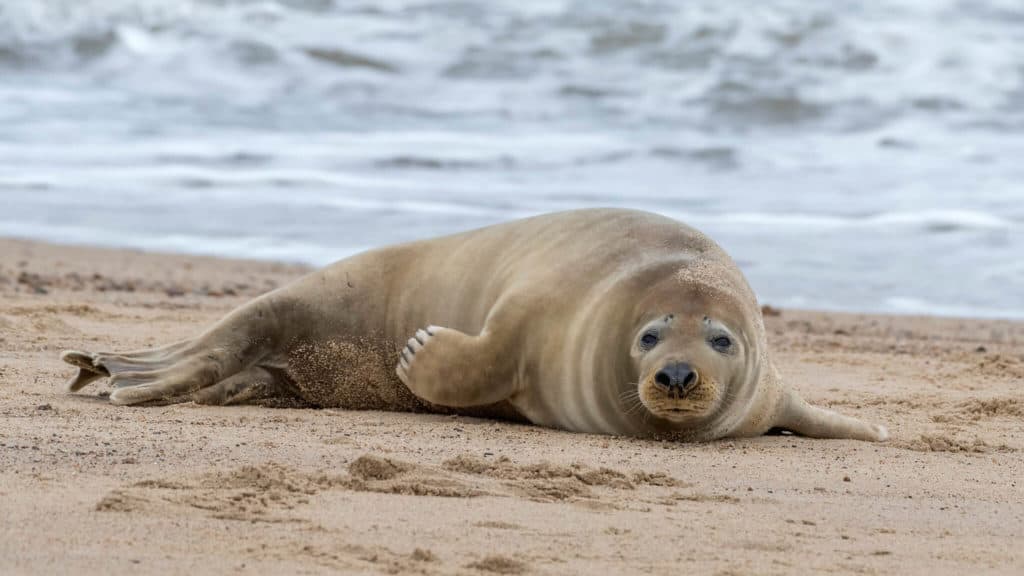Seals are found in many of the world’s cold ocean waters, such as the Arctic and off the coast of the Antarctic.
With around 33 species of seals, they rely on their thick layer of blubber in order to stay warm in the cold, icy waters.
In this post, we’re going to take a closer look at exactly how seals stay warm and answer a question many of our readers ask. Are seals furry?
Yes, many species of seal have fur in order to help keep them warm in the cold waters they inhabit. Some species can have much thicker fur than others, such as the harp seals that live in the Arctic oceans.
Are Seals Actually Furry?
Seals inhabit the coldest oceans on our planet and therefore need their fur to protect them from these icy waters.
Almost all species of seals have fur, with some species such as the fur seal having thick, warm fur that can trap in warmth.
Some seals such as the harp seal have fluffy fur that helps them to absorb sunlight and stay warm whilst they are still developing blubber when they are young.
How Else Do Seals Stay Warm?
As well as a coat of fur to help keep seals warm, they also have a thick layer of blubber that insulates them from the cold.
Blubber is essentially a thick layer of fat that is positioned underneath the skin of many marine mammals, it’s an essential part of keeping them warm in the ocean.
Many seals will also venture onto land when the sun is shining in order to absorb as much sunlight as possible to warm them up.
This is why you may see seals sunbathing when the weather is nice, as they will not pass up on the opportunity to catch some rays when the sun is shining.
Seals, whales, and other marine mammals also have the ability to generate their own heat and maintain a stable body temperature despite fluctuating environmental conditions.
This ensures that seals do not freeze over when in the icy Arctic waters and is essential to their survival.
Do Seals Have Fur Or Hair?
The primary difference between hair and fur is simply the use of the words. The hair of non-human mammals is referred to as ‘fur’, whilst humans are said to have hair.
This means that hair is a characteristic of all mammals, and fur is a reference to the hair of animals.
Seals have fur, as they are marine mammals and non-human. Hair and fur are essentially the same things, but the word fur is more commonly used when discussing seals and other mammals.
Seals have two layers of barb-like hair, a visible outer layer that is compromised of long, dark hairs, and an inner, down-like layer of underfur.
The outer layers are referred to as ‘guard hairs’ and keep the inner layer warm and dry. The hairs have a barbed structure that keeps them stuck together and helps lock in air and heat.
What Type Of Seals Are Furry?
All species of seal have fur in order to keep them warm in the cold oceans, but some species are particularly furry.
The environments the seals live in will typically determine the amount of fur the species of the seal has, for example, seals that live in the Arctic need more fur than seals that live in the Atlantic ocean.
Below I’ve listed some seal species that are furry:
- Harp seals
- Fur seals
- Arctic fur seals
- Ringed seal
- Beareded seal
- Harbor seal
- Leopard seal
- Hawaiian monk seal
Most of the seals live in Arctic water so rely on their fur to keep them warm. The temperature of the Arctic ocean is consistently near freezing points, so it’s essential these seals have thick fur to keep warm.
Final Thoughts
So, are seals furry? Yes, seals rely on their fur in order to stay warm in the cold waters that they live in. They also have a thick layer of blubber that insulates them too.
Not only that, but seals have the ability to generate and maintain a steady body temperature, crucial for surviving in cold environments.
Seals have two layers of barb-like hair that stick together to lock in warm air and help keep them warm.
They can be seen lounging around in coastal towns catching some warm sunlight to help them stay warm, sunbathing isn’t just for humans after all.
Hopefully, this post has been helpful and you’ve learned something new today about how seals stay warm and their fur.
Thanks for taking the time to read this post and feel free to stick around to learn more about seals and other marine life.

Hi, I’m George – the founder of MarinePatch. I created this blog as marine wildlife has been my passion for many years. I’ve spent over a decade in the marine wildlife industry and spent years out in the field conducting research. In today’s modern world, an online blog is the best place for me to share my findings and reach as many people as possible to help educate and inspire others. Enjoy your time here and you’re welcome back anytime!

